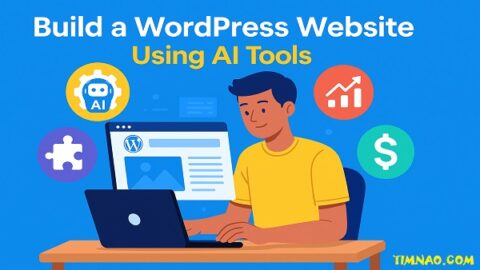🤖 AI Forex Robots: The Game-Changer in Modern Trading
AI Forex robots are reshaping the financial world. Imagine having a virtual assistant that can analyze trends, predict price movements, and execute trades automatically—even while you sleep.
If you’re tired of missing trading opportunities, battling emotions like fear or greed, or manually tracking charts all day, this guide is for you. We’ll break down exactly how to build AI Forex robots from scratch, using simple steps, modern tools, and real-world strategies—even if you’re not a programmer.
Let’s get started on turning your trading ideas into an automated Forex trading system powered by AI.
🧠 What Are AI Forex Robots?
AI Forex robots are automated trading systems that use machine learning algorithms to make trading decisions based on data. These bots analyze historical data, market trends, and even news sentiment to enter and exit trades with precision.
Unlike traditional trading algorithms, AI robots learn and adapt over time. They improve their performance by analyzing more data and adjusting to new market conditions.
Why Use AI in Forex Trading?
- ✅ 24/5 Trading – Works while you sleep
- ✅ Zero Emotional Influence – Data-driven decisions only
- ✅ Speed – Executes trades in milliseconds
- ✅ Real-Time Learning – Continuously adapts to the market
- ✅ Scalable – Monitor dozens of currency pairs at once
🧱 Step 1: Understand the Basics of Forex and AI
Before building your first AI Forex robot, you need a strong foundation in Forex trading concepts and AI fundamentals.
What is Forex Trading?
Forex (Foreign Exchange) is the globe’s largest financial market, where trillions of dollars in currencies are traded daily. It operates 24/5 across different time zones. When you see pairs like EUR/USD or GBP/JPY, you’re looking at the exchange rate between two currencies.
Trading involves speculating on the direction of a currency pair’s price movement. Think the Euro will rise against the US Dollar? You buy EUR/USD. Expect it to fall? You sell. The goal is profit from these exchange rate fluctuations. Forex is often fast-paced, with trades sometimes lasting only minutes, demanding quick reactions – a perfect scenario for AI intervention.
Forex Essentials:
- Currency Pairs: EUR/USD, GBP/JPY, etc.
- Market Hours: Operates 24 hours, 5 days a week
- Leverage & Risk: High rewards, but potential for loss
AI’s Grand Entrance into Trading
Artificial Intelligence is everywhere, from smartphone assistants to streaming recommendations. In finance, AI analyzes vast market data volumes, far exceeding human capacity, to make data-driven trading decisions. It identifies price patterns, trends, and even analyzes news sentiment’s impact on currencies.
How AI Learns: AI trading often uses Machine Learning (ML) algorithms that learn and adapt from historical data. They can recognize precursors to market moves and predict future ones, continuously improving with more data.
AI Concepts to Know:
- Machine Learning (ML): Algorithms that learn from data
- Neural Networks: Mimic brain functions to spot patterns
- NLP (Natural Language Processing): Interprets news and sentiment
- Reinforcement Learning: AI learns from real-world feedback
The Power of AI Forex Robots
AI Forex Robots (also called Expert Advisors or EAs in some platforms) take algorithmic trading further. Unlike rigid traditional algorithms, AI robots dynamically learn from real-time data and adjust strategies. They can analyze multiple markets, process millions of data points, and execute trades with speed and consistency, free from human emotions like fear or greed.
What AI Robots Offer:
- 24/7 Trading: They never sleep, capturing opportunities around the clock.
- Emotion-Free Decisions: Trading based purely on logic and data, avoiding costly emotional mistakes.
- Speed & Efficiency: Executing trades in milliseconds, crucial in fast markets.
- Data-Driven Insights: Analyzing vast datasets (historical, real-time, sentiment) for informed decisions.
- Customizability: Tailoring bots to specific strategies, risk tolerance, and goals.
- Predictive Modeling: Using historical data to forecast potential price moves.
- Automated Execution: Placing trades automatically when signals appear.
- Risk Management: Implementing pre-set rules like stop-losses and take-profits.
The shift from manual to AI-powered trading introduces significant advantages in speed, emotional detachment, consistency, multi-tasking capabilities, and continuous learning. As AI evolves, its influence on Forex will only intensify.
You don’t need a computer science degree—just curiosity and a willingness to learn.
🔧 Step-by-Step Development Guide: Build Your First AI Forex Robot
Let’s get practical and outline the steps to create a basic AI Forex Robot.
✅ Define Your Trading Goals
Ask yourself:
-
What currency pairs will you trade?
-
Will it be short-term scalping or long-term swing trading?
-
What is your risk appetite?
Clear goals will guide the rest of your development process.
✅ Choose a Trading Strategy
Select a strategy that fits your goals:
-
Moving Average Crossover
-
Support and Resistance Breakouts
- Price Patterns
-
RSI or Bollinger Bands-based strategies
Start simple. You can always improve later.
Understanding Basic Trading Strategies
Before your AI Forex robot can trade like a pro, it needs to understand how traders make decisions. Here are some of the most popular and effective Forex trading strategies—and how to teach your robot to use them.
📈 Moving Averages (MA)
Moving averages smooth out price data to highlight the trend.
-
Simple Moving Average (SMA): The average closing price over a set number of days. Easy to calculate, often used to identify long-term trends.
-
Exponential Moving Average (EMA): More responsive to recent prices, making it better for short-term trading.
🧠 AI Application: You can train your bot to spot crossover signals (e.g., when a short-term EMA crosses above a long-term EMA, it’s a buy signal).
🛑 Support and Resistance
These are key levels where price tends to pause or reverse.
-
Support: A price floor where buyers tend to step in.
-
Resistance: A price ceiling where sellers often emerge.
🧠 AI Application: Program your AI robot to trade breakouts, like buying when price breaks above resistance or selling when it dips below support.
🔁 Price Patterns
Visual patterns that suggest future price movements.
Common patterns:
-
Head and Shoulders
-
Double Tops and Bottoms
-
Triangles and Flags
🧠 AI Application: You can train a model (especially with computer vision techniques or labeled data sets) to recognize these patterns and trade them effectively.
📊 RSI & Bollinger Bands Strategies
Here’s the strategy you mentioned—let’s break it down and make it beginner-friendly:
🔄 Relative Strength Index (RSI)
The RSI is a momentum oscillator that ranges from 0 to 100. It helps traders identify overbought or oversold conditions.
-
RSI > 70: Market might be overbought (possible sell signal)
-
RSI < 30: Market might be oversold (possible buy signal)
🧠 AI Application: You can code the robot to monitor RSI and make decisions automatically:
-
Buy when RSI dips below 30 and starts to rise
-
Sell when RSI goes above 70 and starts to fall
📉 Bollinger Bands
Bollinger Bands are made of:
-
A middle line (usually a 20-period SMA)
-
An upper and lower band (standard deviations above and below the SMA)
These bands expand and contract based on market volatility.
-
When the price touches or breaks the upper band: it might be overbought
-
When it drops to or below the lower band: it might be oversold
🧠 AI Application: AI bots can be trained to:
-
Enter countertrend trades when the price hits the bands
-
Use band “squeezes” to detect upcoming breakouts
✅ Select Your AI Framework & Language
Here are some great options:
-
Python: Ideal for beginners. Use libraries like TensorFlow, scikit-learn, pandas, and NumPy.
-
MQL4/MQL5: Built for MetaTrader platforms. Perfect if you want to stay inside MT4/MT5.
-
C#: Use with platforms like cTrader or NinjaTrader.
-
Other Tools: Platforms like Capitalise.ai let you create strategies with plain English. You can even integrate OpenAI’s API for sentiment analysis or signal generation.
✅ Collect and Clean Your Data
Data is your AI’s fuel. Make sure it’s clean.
-
Remove missing or corrupt entries.
-
Normalize and format the data for your AI models.
✅ Code the Robot
Write the trading logic and AI model in your selected language or platform. This is where your plan turns into a working bot.
✅ Test Rigorously
-
Backtest using historical data
-
Paper Trade to test in real-time with zero financial risk
Refine your bot until it shows consistent, reliable performance.
✅ Deploy and Monitor
Deploy your AI Forex robot on a live trading account—but start small!
Use a VPS to keep your robot running 24/7. Monitor performance constantly and tweak your bot as needed.
🛠️ Step 2: Choose Your Tools and Language
Building AI bots requires the right platform and programming tools.
Most Common Choices:
- Python: Most popular language for AI (easy and powerful)
- MetaTrader 5 (MT5): Leading Forex trading platform with built-in AI bot support via MQL5
- cTrader: Great for C# developers with built-in cAlgo for bot creation
- OANDA, FXCM: Offer rich historical and real-time market data via APIs
🧪 Step 3: Develop a Simple Trading Strategy
Your robot needs a strategy. Here are easy ones to start with:
1. Moving Averages (MA) Crossover
- Buy when short-term MA crosses above long-term MA
- Sell when it crosses below
Coding a Simple Example (Python with Moving Averages)
This basic Python script demonstrates a moving average crossover strategy using pandas:
import pandas as pd
import numpy as np
# --- Pretend this loads your historical Forex data ---
# Replace 'forex_data.csv' with your actual data file
try:
# Example: Create dummy data if file not found
dates = pd.date_range(start='2023-01-01', periods=500, freq='D')
prices = np.random.randn(500).cumsum() + 1.1000 # Simulate price movements
data = pd.DataFrame({'Date': dates, 'Close': prices})
data.set_index('Date', inplace=True)
print("Using generated dummy data.")
# data = pd.read_csv('forex_data.csv', index_col='Date', parse_dates=True) # Load real data
except FileNotFoundError:
print("Error: Data file not found. Please provide 'forex_data.csv'.")
exit()
# --- End of data loading ---
# Calculate moving averages
short_window = 50
long_window = 200
data['SMA_Short'] = data['Close'].rolling(window=short_window).mean() # Short MA
data['SMA_Long'] = data['Close'].rolling(window=long_window).mean() # Long MA
# Define trading signal: 1 for Buy (Short MA > Long MA), 0 for Hold/Sell
data['Signal'] = np.where(data['SMA_Short'] > data['SMA_Long'], 1, 0) #
# Create buy/sell signals (1 = Buy, -1 = Sell)
data['Position'] = data['Signal'].diff() # 1 indicates buy entry, -1 indicates sell entry (or exit from buy)
# --- Simple Backtest ---
# Calculate daily returns
data['Market_Returns'] = data['Close'].pct_change() #
# Calculate strategy returns (trade based on *previous day's* signal)
data['Strategy_Returns'] = data['Market_Returns'] * data['Position'].shift(1) #
# Calculate cumulative returns
data['Cumulative_Market_Returns'] = (1 + data['Market_Returns']).cumprod() - 1
data['Cumulative_Strategy_Returns'] = (1 + data['Strategy_Returns']).cumprod() - 1
# Print final cumulative returns
print(f"Total Market Returns: {data['Cumulative_Market_Returns'].iloc[-1]:.2%}")
print(f"Total Strategy Returns: {data['Cumulative_Strategy_Returns'].iloc[-1]:.2%}") #
# --- Optional: Plotting (requires matplotlib) ---
# import matplotlib.pyplot as plt
# plt.figure(figsize=(12, 6))
# plt.plot(data['Cumulative_Market_Returns'], label='Market Returns')
# plt.plot(data['Cumulative_Strategy_Returns'], label='Strategy Returns')
# plt.title('Cumulative Returns: Market vs. Strategy')
# plt.legend()
# plt.show()
This code loads data, calculates SMAs, generates buy/sell signals based on crossovers, and performs a basic backtest comparing strategy returns to market returns. Real robots need more sophistication (risk management, order execution logic, etc.).
2. Support and Resistance Levels
- Enter trades when price breaks through key levels
3. News Sentiment via NLP
- Let AI interpret news and social sentiment to trade before the market reacts
📊 Step 4: Collect and Prepare Your Data
AI models need data. Here’s what to collect:
- Historical price data (Open, High, Low, Close)
- Volume and volatility indicators
- News sentiment (if using NLP)
Use tools like Quandl or broker APIs to get your data.
Preparing and Importing Data
- Sourcing: Get quality historical data from platforms (MetaTrader, cTrader), data providers (OANDA, FXCM, Quandl), or APIs.
- Importing: Load data into your environment (e.g., using
pandasin Python).
Data Cleaning and Feature Selection
- Cleaning: Handle missing values (fill or drop) and remove outliers (unrealistic price spikes) to ensure data reliability.
- Feature Selection: Choose relevant data points (features) for training, such as Price (Open, High, Low, Close), Volume, or Technical Indicators (RSI, Bollinger Bands). Good features improve prediction accuracy.
Clean the data (remove errors and missing values), then select features like moving averages, RSI, or price patterns.
🧠 Step 5: Train Your AI Model
Procedures to training the AI Model:
- Split Data: Divide your cleaned dataset into Training Data (e.g., 80%) and Test Data (e.g., 20%). The model learns on training data and is evaluated on unseen test data.
- Choose Algorithm: Select an ML algorithm (Linear Regression, Random Forest, Neural Networks) based on complexity needs and your expertise. Start simple if you’re a beginner.
- Train: Feed the training data to your chosen algorithm. Using Python’s
scikit-learnlibrary is common.
# Example using scikit-learn (assuming 'data' DataFrame is ready)
from sklearn.model_selection import train_test_split
from sklearn.linear_model import LinearRegression
from sklearn.metrics import mean_squared_error
# --- Prepare Features (X) and Target (y) ---
# Predict next day's Close price based on current day's OHLCV
data['Target'] = data['Close'].shift(-1) # Target is next day's close
data.dropna(inplace=True) # Remove rows with NaN target
features = ['Open', 'High', 'Low', 'Close', 'Volume'] # Example features
X = data[features]
y = data['Target']
# --- Split Data ---
# Ensure chronological split for time series data
split_index = int(len(X) * 0.8)
X_train, X_test = X[:split_index], X[split_index:] #
y_train, y_test = y[:split_index], y[split_index:] #
# --- Choose and Train Model ---
model = LinearRegression() # Simple linear regression
model.fit(X_train, y_train) # Training the model
print("Model training complete.")
# --- Make Predictions on Test Data ---
predictions = model.predict(X_test) #
print("Predictions made on test data.")
# --- Basic Evaluation (Example: Mean Squared Error) ---
mse = mean_squared_error(y_test, predictions)
print(f"Mean Squared Error on Test Data: {mse:.5f}")
# Note: This is a very basic prediction model for demonstration.
# Real trading models need more sophisticated features and evaluation.
Evaluating Model Performance
Training isn’t enough; you must evaluate how well the model performs on unseen data.
- Accuracy: How often predictions match reality? (Note: High accuracy doesn’t always mean high profit if risk isn’t managed).
model.score(X_test, y_test)in scikit-learn gives a basic score. - Drawdown: The peak-to-trough decline in portfolio value during a specific period. Measures risk and resilience during downturns. Lower drawdown is generally better.
- Profitability: Does the strategy make money overall? Simulate trades based on predictions and calculate total return or Sharpe ratio.
🔍 Step 6: Backtest and Optimize
Before going live, backtest your strategy on historical data:
- Was it profitable?
- How big were the losses?
- How consistent were the results?
Then, run walk-forward testing to see how your robot performs on new data it hasn’t seen before. This helps avoid overfitting, where bots perform well on past data but fail in the real world.
Rigorous testing and optimization are crucial before risking real capital.
The Importance of Backtesting and Paper Trading
- Backtesting: Essential for evaluating historical performance, validating strategy logic, and assessing risk. Use realistic historical data including spreads and commissions if possible.
- Paper Trading: Trading live market conditions with virtual money. Tests how the robot handles real-time data feeds, latency, and execution nuances without financial risk.
Avoiding Common Pitfalls: Overfitting
- What is Overfitting? When a model learns the training data too well, including noise and anomalies, making it perform poorly on new, unseen data. It looks great in backtests but fails live.
- Signs: Unrealistic backtest results (extremely high returns, near-zero drawdown); poor performance in paper trading despite good backtests.
- Prevention:
- Keep models simpler; avoid excessive complexity.
- Use more data covering various market conditions.
- Employ regularization techniques (like L1/L2) if using advanced ML.
- Crucially, use Walk-Forward Testing.
Optimizing for Performance and Reducing Risk
Optimization aims to improve profitability while minimizing risk.
- Performance Optimization:
- Hyperparameter Tuning: Adjust model parameters (e.g., learning rate, number of trees in a random forest).
- Strategy Variable Adjustment: Experiment with indicator settings (e.g., different MA periods), entry/exit rules.
- Add More Data/Features: Enhance model robustness with more diverse data or better predictive features.
- Risk Reduction:
- Stop-Loss & Take-Profit: Implement strict exit rules to limit losses and lock in profits.
- Position Sizing: Dynamically adjust trade size based on account equity, volatility, or confidence in the signal. Avoid risking too much on a single trade.
- Risk-Reward Ratio: Aim for strategies where potential profit significantly outweighs potential loss (e.g., 1:2 or higher).
- Diversification: Don’t rely on a single strategy or pair. Use multiple, uncorrelated strategies if possible.
🎯 Step 7: Go Live and Monitor (Integrating Robots with Trading Platforms)
Your tested robot needs to connect to a broker via a trading platform to execute trades live.
Popular Trading Platforms Supporting Automation
- MetaTrader 4/5 (MT4/MT5): Industry standards, especially MT5 for multi-asset trading. Use MQL4/MQL5 language for “Expert Advisors” (EAs). Offers built-in strategy testers.
- cTrader: Known for clean interface, Depth of Market (Level II) pricing, and uses C# for “cBots” via cAlgo. Offers backtesting features.
- NinjaTrader: Popular for futures but supports Forex. Uses C# and offers advanced charting and analysis tools. Has extensive third-party add-on support.
- Broker APIs: Many brokers (FOREX.com, Alpaca) offer APIs (REST, FIX) allowing direct connection from custom applications (e.g., Python scripts) for greater flexibility and control. Requires handling authentication and API calls for data and execution.
Implementation Steps (General)
- Choose Platform/Broker: Select one that supports automated trading and suits your needs/coding language. Ensure the broker is regulated.
- Code Adaptation: Write or adapt your robot’s code for the platform’s specific language (MQL, C#) or API requirements.
- Testing within Platform: Use the platform’s backtester/simulator extensively.
- Deployment: Attach the EA/cBot to a chart or run your API-connected script. Start on a demo account first!
- Connectivity: Ensure stable internet. For 24/7 operation, use a Virtual Private Server (VPS).
Practical Integration Tips
- Use a VPS: Essential for uninterrupted 24/7 trading.
- Monitor Closely: Especially initially. Check logs, performance, and error messages.
- Set Alerts: Configure notifications for key events (large trades, errors, significant drawdown).
- Build Fail-Safes: Code defensively. Include error handling, maximum position size limits, and emergency stop mechanisms.
Deployment isn’t the end; it’s the start of active management. AI robots aren’t “set and forget.”
Best Practices for Real-Time Monitoring
- Dashboards: Visualize key metrics (P/L, win rate, drawdown, open positions) for quick assessment.
- Logging: Record all trades, decisions, and errors for analysis and debugging.
- Alerts: Crucial for immediate notification of issues or significant events.
- Regular Reviews: Periodically (daily/weekly) assess performance against goals and expectations.
Adjusting Models for Market Conditions
Markets change. Your AI needs to adapt, or you need to intervene.
- Condition-Based Logic: Program the robot to modify behavior based on volatility, liquidity, or specific news events (e.g., reduce size during high volatility).
- Scenario Testing: Simulate performance under potential future conditions (e.g., flash crash, interest rate hike).
- Feedback Loops: Implement mechanisms for the AI to learn from recent performance and adjust (if using adaptive models).
Continuous Learning and Updating
AI’s power lies in adaptation.
- Feed New Data: Regularly update the model with the latest market data to keep it relevant.
- Periodic Retraining: Retrain models occasionally to incorporate new patterns and market behavior.
- Use Adaptive Algorithms: Techniques like RL allow models to learn continuously.
Managing AI Robot Risks
Even AI faces risks.
- Risk Framework: Define max drawdown, risk per trade, stop-loss rules before going live.
- Diversification: Spread risk across multiple strategies, pairs, or even asset classes if feasible.
- Performance Evaluation: Continuously check if the robot meets risk objectives. Pause or revise strategies that consistently underperform or exceed risk limits.
- Black Swan Preparedness: Have contingency plans for extreme, unexpected market events (“black swans”). Know when to manually intervene or shut down the robot.
- Technical Failures: Be prepared for glitches, connectivity issues, or platform outages. Monitor system health.
🧠 Advanced Techniques to Supercharge Your Bot
Ready to make your robot smarter? Explore these cutting-edge techniques.
Reinforcement Learning (RL)
- Concept: AI learns optimal behavior through trial-and-error, interacting with the market (environment) and receiving rewards (profits) or penalties (losses) for its actions (trades).
- Forex Application: Robots learn adaptive strategies that evolve with changing market dynamics without explicit programming for every scenario. They figure out when to buy/sell based on maximizing long-term rewards.
Natural Language Processing (NLP) for Sentiment Analysis
- Concept: Enabling machines to understand human language.
- Forex Application: Analyze news articles, tweets, reports to gauge market sentiment (bullish/bearish). Trade based on sentiment shifts or react instantly to breaking news. Provides insights beyond technical charts.
Deep Learning (DL) for Advanced Pattern Recognition
- Concept: Multi-layered neural networks that automatically discover complex patterns and hierarchies in data.
- Forex Application:
- Identify subtle, non-linear price patterns missed by traditional analysis.
- Detect market anomalies or rare opportunities.
- Understand complex correlations between currencies and other assets (commodities, indices). Used by major firms like Goldman Sachs.
Adaptive AI and Advanced Risk Management
- Risk Algorithms: Go beyond simple stop-losses.
- Dynamic Position Sizing: Adjust trade size based on volatility, equity, or signal confidence.
- Trailing Stops: Lock in profits as a trade moves favorably.
- Adaptive Models: AI systems that continuously learn and evolve after deployment.
- Self-Learning: Refine strategies based on ongoing market data and trade outcomes.
- Market Regime Adaptation: Recognize shifts (e.g., trending vs. ranging) and automatically switch to more suitable strategies.
📈 Real-Life Success Stories
Learning from real-world examples provides invaluable insights.
Examples of Successful AI Robots
- Grid Traders: Place buy/sell orders at set intervals, profiting from volatility within a range. One firm reportedly achieved 35% ROI using this relatively simple concept.
- News Sentiment Traders: Use NLP to trade based on breaking news and market sentiment. A retail trader reportedly saw 50% ROI by capitalizing on news-driven moves.
- Neural Network Analyzers: Leverage deep learning to find complex patterns. A hedge fund reportedly achieved 60% ROI using such a system.
- Institutional Use: Firms like Goldman Sachs and XTX Markets heavily use AI/algorithmic trading for efficiency, risk management, and profitability, handling massive volumes.
Key Lessons from Success
- Data is King: Success hinges on quality data and rigorous analysis.
- Stay Informed: Even with automation, understanding broader market context helps.
- Risk Management is Non-Negotiable: Protecting capital is paramount.
- Adapt or Perish: Continuous learning, testing, and refinement are essential in dynamic markets.
Common Mistakes to Avoid
- Insufficient Backtesting: Skipping rigorous historical testing is a recipe for disaster. Tip: Test thoroughly across diverse market conditions.
- Overfitting: Creating models that only work on past data. Tip: Prioritize robustness over perfect backtest results; use walk-forward testing.
- Ignoring News/Events: Over-reliance on technicals while ignoring fundamental drivers. Tip: Stay aware of major events; consider integrating NLP.
- Lack of Monitoring: “Set and forget” is dangerous. Tip: Implement real-time monitoring and alerts.
⚖️ Legal and Ethical Considerations
Profit potential must be balanced with responsibility.
Regulations for Automated Trading
The Forex market is regulated; automated trading isn’t exempt.
- Jurisdictional Rules: Regulations vary globally (e.g., CFTC/NFA in the US, MiFID II in Europe). Understand the rules where you trade.
- Broker Regulation: Crucial to use a well-regulated broker to protect funds and ensure fair practices.
- AML/KYC: Compliance with Anti-Money Laundering and Know Your Customer rules is standard.
- Algorithm Disclosure: Some regulators may require disclosure of algorithms, especially for institutional players. Transparency is increasingly emphasized.
Ethical Considerations
- Responsible Trading: Avoid manipulative practices (spoofing, layering) that distort markets.
- Fair Competition: Don’t seek unfair advantages through illicit means (insider info, exploiting system flaws).
- Transparency: Be honest about performance claims if sharing results.
Avoiding Algorithmic Bias
AI models can inadvertently learn biases from data, leading to unfair or skewed outcomes.
- Use Diverse Data: Train on data representing various market conditions and scenarios.
- Regular Audits: Check if the model unfairly favors/ignores certain pairs or conditions.
- Refine if Biased: Actively work to remove detected biases through retraining or algorithm adjustment.
Ensuring Transparency and Fair Trading
- Document Everything: Keep clear records of your strategy logic, parameters, and risk management.
- Communicate Clearly: If managing funds for others, be transparent about methods, risks, and performance.
- Establish Ethical Guidelines: Define your own commitment to fair and responsible automated trading.
🏁 Final Thoughts: Start Small, Dream Big
The future of trading is automated, intelligent, and data-driven. With AI Forex robots, you’re not just trading—you’re building a smart system that works for you 24/7.
Start small. Focus on one strategy. Build. Test. Learn. And when you’re ready, unleash your bot on the live market with confidence.
Building an AI Forex robot isn’t just for quants or coders anymore—it’s for anyone willing to learn.
So, what are you waiting for?
💬 Ready to build your first AI Forex bot? Share your journey or questions below—we’d love to hear from you!
More information about AI Forex Trading , check here: https://timnao.com/mastering-ai-forex-trading-2025-guide-to-strategies-tools-risk-management/
Reference video:









